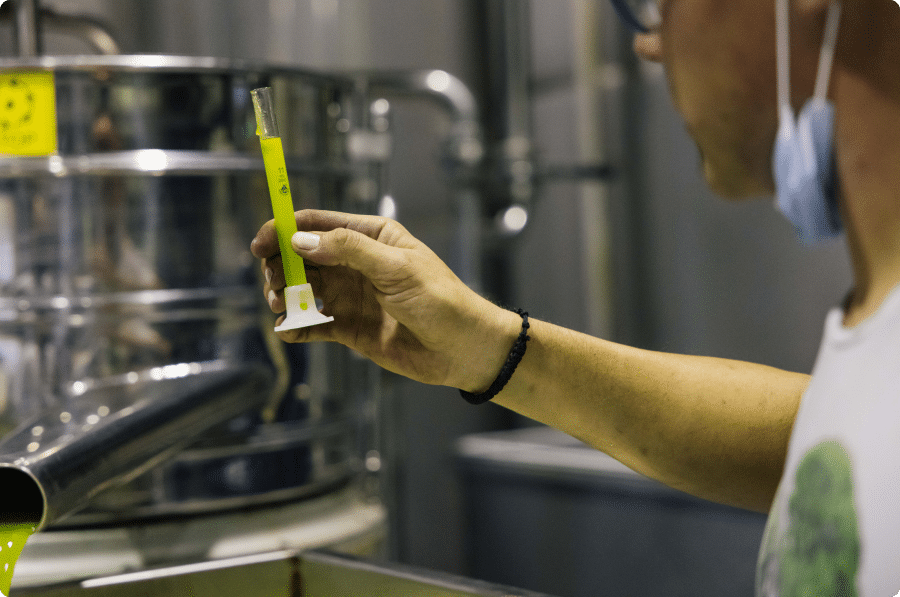Olive oil vs. canola oil. What are the health benefits, and what are the differences? Is canola oil better than olive oil, or the other way around? Numerous studies have been conducted on both oils, so please don’t come at us too hard for lacking nuance. We’re simply laying out a few facts about each: olive oil vs. canola oil!
What is extra virgin olive oil?
Let’s start at the beginning. Today, we’re comparing our organic, extra virgin olive oil. To label something as organic olive oil, it must meet certain requirements. For instance, no artificial fertilizers or pesticides may be used, and you must be able to trace exactly where your olives come from.
Olive oil is considered extra virgin when it comes from the first cold pressing (without heat) using mechanical means. This immediate, cold pressing retains most nutrients and keeps the acidity below 0.8 percent. Additionally, the median score of the 12 olive oil defects must be 0, and the median fruitiness must be above 0. The result is a rich flavor and an olive oil with the highest amount of polyphenols, antioxidants, vitamins, and minerals.
Extra virgin olive oil is great for cold use in salads, but as we now know, it’s also perfect for cooking and baking.

What is canola and canola oil?
The canola plant is widely used in agriculture, though there’s also a wild variant known as rapeseed. You’ll recognize the plant by its yellow flowers blooming in spring along roadsides in the Netherlands. Because they’re closely related, the terms are often used interchangeably.
Canola oil hasn’t been used as food for very long. It was originally used mainly as lamp oil. It’s a vegetable oil derived from the seeds of canola (Brassica Napus). The taste is mild and neutral, which is why it’s sometimes preferred over the more present flavor of olive oil (which, of course, we can hardly imagine).

Olive oil vs. canola oil: good and bad fats
Extra virgin olive oil contains saturated fats (about 10%) as well as omega-3 and omega-6 fatty acids (olive oil has one of the highest levels of omega-6 among oils). The stars of the show, though, are the monounsaturated fats, mostly in the form of oleic acid. These fats are linked to reduced blood pressure and lower cholesterol, both of which are associated with a decreased risk of heart disease. Extra virgin olive oil is made up of roughly 70% monounsaturated fats and about 8% polyunsaturated fats (read more about unsaturated fats in olive oil). Research shows, as we’ve written before, that olive oil benefits heart health in multiple ways and helps reduce cardiovascular risks.
Canola oil has the lowest percentage of saturated fat of all plant-based oils, about 7%. It also contains valuable omega-3 and omega-6 fatty acids, and a high proportion of unsaturated fats: about 60% monounsaturated fats and around 30% polyunsaturated fats (source). Omega-6 (also known as linoleic acid) are essential polyunsaturated fatty acids. They may help reduce cholesterol production and strengthen the immune system. The natural balance of omega fats in canola oil is quite good. Want to know more about different oils and their health benefits? Read this clear comparison.
First conclusion: both oils score great in terms of unsaturated fat content, but canola oil scores just a bit higher. 1-0 for canola oil!

Heating: olive oil vs. canola oil
Some sources say canola oil can be safely heated up to 180°C (356°F) (source). Opinions vary on whether you should heat it at all, and it’s generally discouraged. If you do choose to cook with canola oil, only use it once and be careful not to exceed 180°C. When the oil starts to smoke, you know it’s gone too far.
Extra virgin olive oil is similar, but has a higher smoke point. It can be heated up to 207°C (404°F). Since deep-frying is usually done at 180°C, olive oil gives you more room to work safely. For more details on this, read our guide on heating extra virgin olive oil. Olive oil vs. canola oil, 1-1!
Vitamins and minerals in olive oil and canola oil
Extra virgin olive oil is rich in polyphenols (especially Hydroxytyrosol and Tyrosol) and antioxidants (full of vitamins A, D, E, and K). It also contains sodium, which supports fluid balance, blood pressure regulation, and nerve function.

Canola oil naturally contains lots of vitamin E and K (source). We couldn’t find evidence of other significant vitamins or minerals. Olive oil or canola oil: 2-1.
Health rating
The Dutch Nutrition Value Table also gives ratings for various oils. Olive oil scores an 8.3, the highest of all listed oils. Unfortunately, no score is listed for canola oil — possibly due to lack of data. What’s there instead is a “perceived value”: a 5.3…
This is probably due to the production process. While (our) organic extra virgin olive oil is made completely naturally without chemical processes, many canola oils are produced through …
















